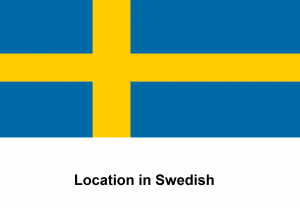Language/Swedish/Grammar/Location
Hello Everyone, 😊
In today’s lesson we are going to study the following topic: ”LOCATION” in Swedish
Please feel free to edit this page if you think it can be improved!
Happy learning!
Consider broadening your understanding by checking out these related lessons: Future Tense, Learn Swedish Sentense Structure. Subject, Verb and object., Verbs with prepositions & How to express ownership.
Location in Swedish[edit | edit source]
Rule[edit | edit source]
The rule is that you have to decide if the person or thing is already at the location or if it is moving there.
You express it if the person or thing is already in place, for example like this:
- Jag är här/där/inne/ute etc. (I am here/there/inside/outside) -> so most times the letter "e" in the end shows, the person or thing is in place.
If the movement and direction to the place is emphazised, you express this for exampel:
- Jag går hit/dit/in/ut etc. (I go here/there/in/out) -> so often the letter "e" in the end is missing and you have always a verb which expresses the movement, motion, direction like att resa, att åka, att komma etc.
Att gå hem is used, when you go directly to your home and have reached there. Att gå hemåt is used, when you make a stopp (for example at the supermarket to buy things) and are on your way home.
If you go from where you are (=ifrån) till there (=där), you use därifrån, from where you are (=ifrån) till here (=här) härifrån etc..
I wrote a funny text going round my house and garden with my kat which examplify these small location words and how to use them according to the stated rule in a playful way:
Example of use[edit | edit source]
Upp och ner eller hemma hos mig
Jag gick hem/hemåt från universitetet. Så jag är hemma nu. Jag kom utifrån in, men jag är inne nu. Jag kom inifrån och går ut på garden.
Jag är ute och här i min garden, min katt är ute också och där. Katten kom hit till mig! Naturligtvis katten kommer inte hit. Så jag går härifrån dit, tillsammans kommer vi därifrån hit. Vi är här nu och inte mer där.
Vi är ute och går utifrån in. Katten går ner i källaren, katten är nere. Jag går upp till taket, jag är uppe. Jag går uppifrån ner till köket, katten går nerifrån upp till köket. Jag kommer härifrån, katten kommer därifrån.
Vi är lätt förvirrad tillsammans hemma hos mig och tänker vi måste ha mer orienting. Så går jag hemifrån till universitetet för nästa svenska lektionen. När jag kommer hem, allt startar igen! Men när jag är inte inne, vet jag aldrig vart katten går eller vårifran katten kommer...den kan också ingen berätta!
I hope you had fun, there are more position-words like bakom or framför, if you want to supply these or more, please feel free to do so!
Author[edit | edit source]
https://polyglotclub.com/member/Ljus
Other Lessons[edit | edit source]
- Pronouns
- Possessive Case in Swedish
- Passive Voice
- How to Describe Someone's Appearance and Personality
- How to Talk About the Weather
- How to express disagreement
- Prepositions
- How to Use Be
- Present Tense
- How to Talk About How Something Smells

